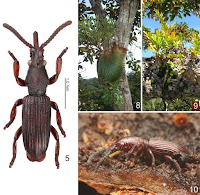Abstract
Pycnotarsobrentus inuiae Maruyama & Bartolozzi, gen. nov. and sp. nov. (Brentinae: Eremoxenini) is described from the Lambir Hills National Park, Borneo (Sarawak, Malaysia) based on specimens collected from Crematogaster difformis F. Smith, 1857 ant nests in the myrmecophytic epiphytic ferns Platycerium crustacea Copel. and Lecanopteris ridleyi H. Christ. A second species of Pycnotarsobrentus is known from Malaysia but is represented by only one female and consequently not yet described pending discovery of a male. Pycnotarsobrentus belongs to the tribe Eremoxenini and shares some character states with the African genus Pericordus Kolbe, 1883. No species of Eremoxenini with similar morphological modifications are known from the Oriental region.
Keywords: Myrmecophily, Crematogaster difformis, Eremoxenini, Malaysia
Pycnotarsobrentus Maruyama & Bartolozzi, gen. nov.
Type species. Pycnotarsobrentus inuiae Maruyama & Bartolozzi, sp. nov., by present designation.
Differential diagnosis. This genus is close to the African genus Pericordus Kolbe, 1883, in the head and
rostrum lacking depression or carinae, short antennae, laterally compressed femora and tibiae, and rather thick and
short tarsi, but clearly distinguished from it by the antennal segments being cylindrical, rugose and rather
compressed, with the apical segment rounded at apex, by the mesorostrum being not convex, by the tarsi being
shorter, with parallel-sided segments and extremely short tarsal segment IV.
Etymology. The generic name is derived from Greek words meaning “stout tarsi-bearing brentid” for one its
important character states: the thick, short tarsi. Gender masculine.
Pycnotarsobrentus inuiae Maruyama & Bartolozzi, sp. nov.
Differential diagnosis. No species of Eremoxenini with similar morphological modifications are known from
the Oriental region and the new taxon is easily distinguishable from all other Asian Eremoxenini by the generic
diagnosis.
Etymology. Dedicated to Dr. Yoko Inui, one of the collectors, for her invaluable contribution to the knowledge
of tree canopy ant communities.
Bionomics. The beetles were found exclusively inside the nests of C. difformis in the domatia of the epiphytic
ferns (Figs. 8, 9). They were observed to walk slowly when the nests were excavated (Fig. 10, 11), and the ants did
not pay any attention to them. Ecological studies on the communities of the myrmecophiles in the nests of C.
difformis are in progress by the Japanese authors.
Maruyama, Munetoshi, Luca Bartolozzi, Yoko Inui, Hiroshi O. Tanaka, Fujio Hyodo, Usun Shimizu-Kaya, Yoko Takematsu, Takuo Hishi and Takao Itioka. 2014. A New Genus and Species of Myrmecophilous Brentid Beetle (Coleoptera: Brentidae) Inhabiting the Myrmecophytic Epiphytes in the Bornean Rainforest Canopy.
Zootaxa. 3786(1); 73–78. DOI: 10.11646/zootaxa.3786.1.5
Zootaxa. 3786(1); 73–78. DOI: 10.11646/zootaxa.3786.1.5





